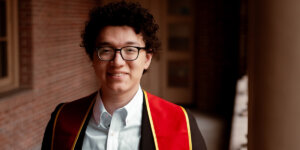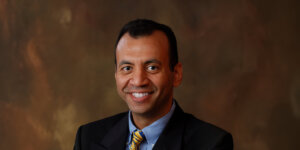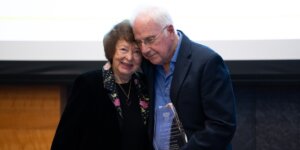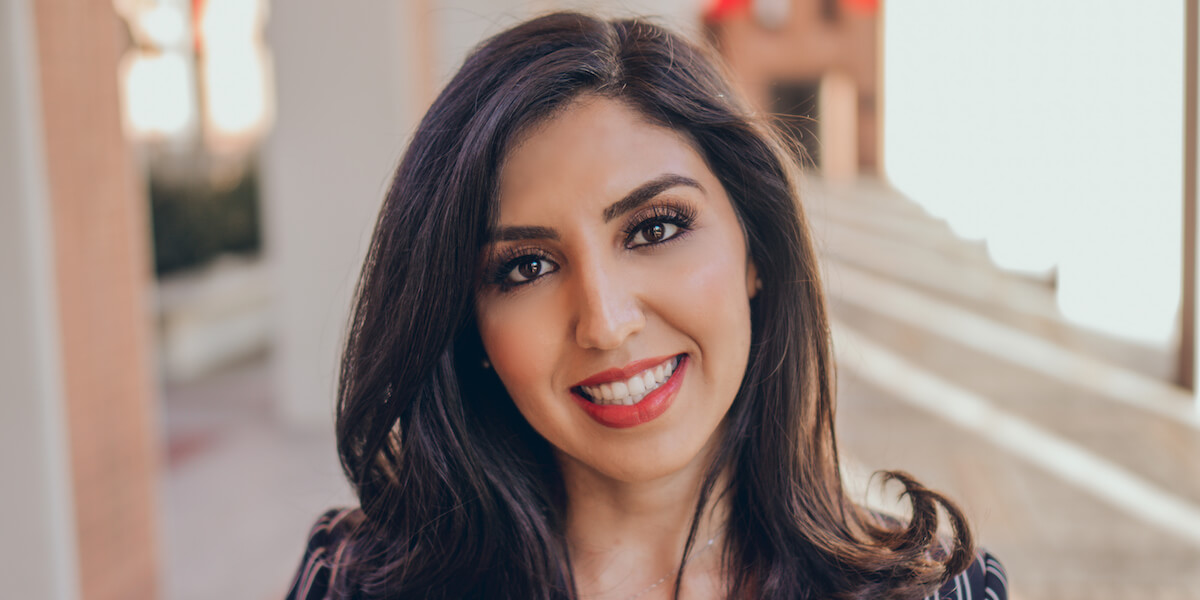
Niki Bayat (Photo/Courtesy Niki Bayat)
Niki Bayat, M.S. CHEM ENG ’14 and Ph.D. CHEM ENG ’18, has been named by the MIT Technology Review to the prestigious 2018 TR-35 list of the world’s leading innovators under 35. Bayat – who studied under the supervision of Professor Mark Thompson, a renowned chemist, and with collaboration of Professor Mark Humayun, the developer of the first artificial retina – is the first USC doctoral student to have earned the TR-35 distinction. In the past nine years, USC Viterbi has won 13 TR-35 awards, of whom nine are female engineers. “I am sure you all share my pride in this tremendous accomplishment from our faculty and students,” USC Viterbi Dean Yannis C. Yortsos said.
During her Ph.D. studies, Bayat, now 32, developed innovative biomedical devices, including an injectable hydrogel for sealing eye injuries. She also helped create smart hydrogels that can be inserted into tear ducts to time release medicine to treat dry eye and, in the future, glaucoma.
In 2016, Bayat cofounded AesculaTech to commercialize her hydrogels and drug-delivery technologies. She and her startup won third place among 29 participants from around the world in the 2016 Innovation Coast Conference & Competition; second place among 148 teams in the 2015 Lloyd Greif Center for Entrepreneurial Studies’ New Venture Seed Competition; and second prize in the 2015 Maseeh Entrepreneurship Prize Competition, or MEPC. Most recently, AesculaTech was chosen to reside in the Y Combinator, a business accelerator consistently ranked as the nation’s best.
Bayat, the recipient of the 2018 USC Ph.D. Achievement Award, spoke with USC Viterbi senior writer Marc Ballon about becoming a TR-35 recipient and her vision for AesculaTech.
There are so many awards for science and tech – what makes this award so special for you?
I cannot think of many awards for young talents, all under the age of 35 in the innovation realm, with the prestige of the MIT Technology Review Innovator Under 35. I knew some of the winners even before they were awarded. What they all contributed to society is not only creating the breakthroughs, but also the inspiration, enthusiasm and commitment to what they believe in. A group of people with great human qualities and eager to make things better is what makes this award so unique.
What exactly did you win for?
This is not an award that you apply for and win for a specific achievement. You must be nominated by someone else and it takes into account all your achievements over the years.
What does AesculaTech make? What makes the product unique?
Smart materials are changing our world. There is an overwhelming trend across multiple industries where materials capable of interacting with, and responding to, their environment prove immensely valuable. For example, Nitinol, a shape-memory alloy comprised of nickel and titanium, revolutionized the medical device industry by enabling stents and valve replacements that can be deployed via catheter in a compact form before springing into their desired final shape in situ, permitting significantly less invasive insertion procedures.
We develop and manufacture a platform of temperature-responsive smart materials that hold similar promise.
We started with the treatment of dry eye, through the use of a shape adaptive punctal plug. This first product, AesculaGel, has the potential to dramatically improve the quality of life for the 150 million Americans who regularly experience symptoms of this disease. In future, we plan to develop a platform of medical devices that can be individually shaped to the unique anatomy of each patient. Beyond medical devices, we believe our platform can address opportunities in drug delivery, chemical separations, wound healing, tissue scaffolding, and additive manufacturing, inter alia.
Compared with other biomaterials, the most significant features of our platform are its reversibility and pre-polymerized nature. While other systems exist that can be activated in situ and adapt to shape, those systems are typically irreversible and involve polymerization reactions that leave behind potentially toxic byproducts, monomers or initiators.
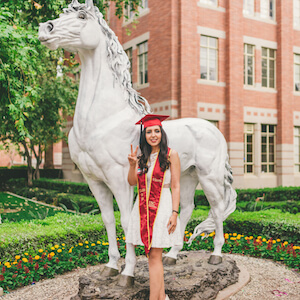
Recent Ph.D. graduate Niki Bayat received the 2018 USC Ph.D. Achievement Award (Photo/Courtesy Niki Bayat)
What are the benefits of AesculaGel? If the product simply didn’t exist, what would that mean?
Currently, patients with dry eye have three main treatments available: artificial tears, pharmaceutical drops and punctal occlusion. Artificial tears have an extremely short duration of effect, must be applied 6+ times per day, and are ineffective. Pharmaceutical drops are expensive; must be applied daily; have numerous side effects; are only effective in 15 percent of the patient population; and take three to six months to work. Pre-formed punctal plugs are a one-time treatment that provide rapid symptom relief for 80 percent of patients, but within six months 50 percent of plugs become dislodged.
By contrast, AesculaPlug offers a real solution to the last treatment. Since it is administered as a liquid, it adapts to the unique anatomy of each patient’s tear ducts and blocks the drainage of tears, increasing the amount of fluid on the surface of the eye and relieving the patient’s symptoms.
Why do you refer to AesculaGel as “reverse chocolate?” Please elaborate.
I think it’s a very tangible way to describe a material which is liquid until heated to body temperature, when it turns into a gel. This is exactly the reverse of a chocolate that is solid until heated.
How does AesculaGel work? How would doctors deliver medication to patients?
Our first product is a treatment for dry eye syndrome that adapts to the unique anatomy of each patient’s tear ducts and blocks the drainage of tears, increasing the amount of fluid on the surface of the eye and relieving the patient’s symptoms. This smart plug is administered by doctors as an injectable liquid that becomes solid when heated to body temperature and, in the process, takes the shape of each individual’s tear duct. It requires no sizing and adapts to the unique anatomy of the patient.
How has being in the famed Y Combinator incubator strengthened AesculaTech?
I have been through different business competitions and programs, and I have learned a lot from each one. Y Combinator was one of the most challenging and enjoyable experiences of my life so far. Indeed, a life-lasting experience.
Y Combinator is what many call the “Harvard of entrepreneurship.” It is not about the money. It is about the opportunity to be surrounded with brilliant entrepreneurs, who come from all over the world to listen, learn, and share their experiences with you. In addition, it is amazing how you get connected with so many of the country’s biggest investors, develop a business plan, and an appropriate financial model. Backing from the Y Combinator, with its great track record, is a game changer.
Have you done any animal or clinical trials yet?
Yes, we have done animal studies and the results showed significant increase in tear retention, with no irritation or adverse events. And I am extremely excited to announce that our first human clinical trial was also completed. The results indicated safety and efficacy of our product.
When do you expect to have AesculaGel or other products FDA approved and ready for sale?
This technology will be developed through a 510(k) class 2 regulatory pathway to an FDA approved product with anticipated approval in 2019.
You recently served as lead author on a research paper in “Science Translational Medicine” about the development of a reversible, temperature-sensitive temporary seal that changes from a fluid to a super-strong semi-solid when applied to the eye. How does this portable eye gel increase the odds of saving an injured eye, especially in the battlefield? Why is this important?
Traumatic eye injuries require rapid treatment to prevent loss of vision. Suturing, which is currently the only option to seal injuries to the eye surface, requires equipment and expertise and cannot be performed in the field. As an alternative, we have developed a novel, biocompatible hydrogel that acts as a temporary sealant. This injectable hydrogel solidifies quickly as it comes in contact with injured tissue and consequently seals the open globe eye perforation. Since gelation is reversible, this ocular sealant could later be removed readily by exposure to cold water. This much needed invention addresses an ongoing need to develop simple, affordable, and efficient medical technologies for traumatic eye injuries and related vision dysfunction suffered by military personnel and veterans, among others.
Who are some of the other principal researchers on this team?
Professor Mark Thompson, Professor Mark Humayun, Dr. John Whalen, Yi Zhang, Dr. Paulo Falabella, and Roby Menefee. This study was a collaboration between chemists at the USC Dornsife College of Letters, Arts and Sciences, engineers at the USC Viterbi School of Engineering, scientists at the USC Institute for Biomedical Therapeutics, and the Keck School of Medicine of USC.
How did studying at USC help you become a TR-35 honoree and an entrepreneur?
During the course of the Ph.D. at USC, I was engaged in the design, synthesis, and characterization of polymeric materials, where I was the leading student in a project developing biomaterials to treat ocular trauma. The program gave me extensive experience in chemistry, chemical engineering, and material science which I use to contribute to the development of new materials and perform diligence on potential applications. My training allowed me to translate the abstract clinical issues I have uncovered through discussions with doctors into engineered, material-based solutions. USC also has great programs that support entrepreneurship activities. For example, Maseeh Entrepreneurship Prize Competition (MEPC), which was one of the first competitions in my entrepreneurship journey, definitely had a great impact.
What’s next for Niki Bayat?
Nothing motivates me more than seeing that my research has resulted in improvement of a patient’s condition. I have been, and continue to be, actively engaged in the field of chemical and biomedical engineering through collaborations with research laboratories in academia, industry and as co-founder and CSO of AesculaTech. Upon completion of my Ph.D., I look forward to focusing more on my startup company and making my dreams reality.
As engineers, we strive make the world a better place. Nothing gives me more satisfaction than using my skills to create superior treatment options for patients.
Published on June 28th, 2018
Last updated on June 17th, 2025




